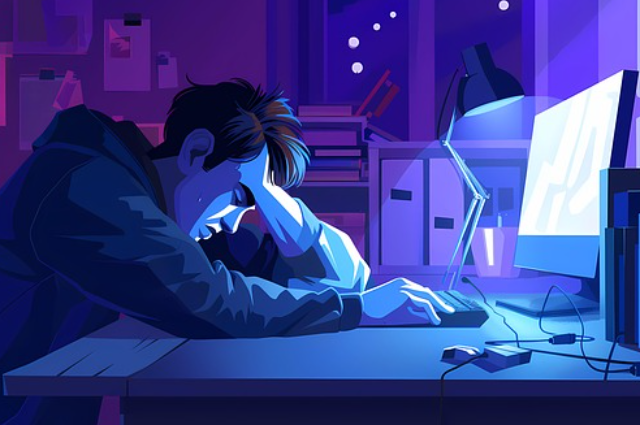
Image by Vilius Kukanauskas from Pixabay
The word 'burnout' refers to a feeling of exhaustion. It is a state of physical, mental, emotional, and chronic exhaustion. Digital burnout refers to the exhaustion that results from prolonged use of digital devices.
In the modern world, the use of technology is inevitable. Everything, including study and work, revolves around screens. Because of this, a large number of the population, including students, teachers, and professionals, are being affected by digital burnout.
According to recent studies and research, digital burnout is real and is recognised as a rising problem by psychologists. It is caused by constant exposure to digital devices, harmful screen light, constant online interactions, and information overload. So we can say digital burnout is an epidemic in the digital world.
General burnout is due to excessive stress and workload, whereas digital burnout is due to online platforms. The symptoms of digital burnout include irregular sleep patterns, pain, irritation, numbness, fatigue from screen time, and feeling drained after online interactions. In the case of digital burnout, the primary causes are digital devices. The groups most affected are remote workers, students, teachers connected through online platforms, social media users, and digital content creators.
Causes of Digital Burnout
- Exposure to Screens for a Long Time: The constant exposure to screens for 7-8 hours or even more for students and workers is the prominent reason for burnout. The blue light coming from the screen affects the circadian rhythm. Breaks in between are a must.
- Information Overload: In today's world, every piece of information is at our fingertips. There is a constant flood of news and updates, causing severe cases of burnout.
- Expectations: Nowadays, it is expected of everyone to be online 24/7. People should respond immediately, which contributes to burnout.
- Boundaries: In the digital world, it is difficult to maintain boundaries between professional and personal life. Most of life is online nowadays.
- Comparison: Social media increases the tendency for comparison, daydreaming, and fear. Rather than enjoying our own lives, we constantly compare them with others.
Impact of Digital Burnout
- Mental Health: Digital burnout impacts health in numerous ways. It causes anxiety and depression, and reduces attention span. It diminishes the capacity to ponder and reflect.
- Productivity: Excessive use of digital devices can lead to procrastination, distraction, and poor quality of work instead of efficiency and excellence.
- Relationships: Online interactions can replace real emotional connections. People may feel distracted even during their quality time with loved ones, which can increase loneliness.
- Physical Health: Digital eye strain, poor posture, migraines, and sleep disorders can occur due to an imbalance in the production of melatonin. Lack of movement and sitting in a similar posture at a digital system can affect overall health.
Is digital burnout real?
Is digital burnout real? Yes—digital burnout is not just a feeling; it’s a real psychological and physiological condition. While it is not yet officially classified as a separate medical disorder, researchers and psychologists widely recognise its impact on humanity.
A study by the American Psychological Association reported an alarming increase in stress and mental fatigue related to digital life, especially post-pandemic. The WHO’s classification of "burnout" as an occupational phenomenon also points to the way digital environments are giving rebirth to the term burnout. Experts like Cal Newport, author of Digital Minimalism, highlight how constant digital stimulation rewires brain function, affecting attention and emotional regulation. Neuroscientists have also found that excessive digital use leads to changes in dopamine regulation—the same brain chemical involved in addiction.
Solutions:
- Digital Detox: The way we take care of the hygiene of our physical body and the way we declutter our mind is similar to how we need to take care of our digital hygiene. Proper breaks, with mindfulness and quality content, should be taken into consideration.
- Offline Activities: Add some offline fun activities to your day, such as a morning walk in fresh air, having a conversation with someone offline, or visiting a nearby cafe.
- Mindfulness: Being mindful and conscious about the time spent on social media and other platforms is crucial.
- Physical Environment: Avoid using digital devices before sleeping. Use blue light filters and keep digital devices away from the bedroom.
- Support: Governments, institutions, and other authorities need to acknowledge digital fatigue. They should create a flexible work environment that can support healthier exchanges between the real and digital worlds.
- Reconnection: Reconnect with the real world by using your creativity and practising being in silence.
In today's world, it is impossible to keep ourselves away from digital devices, especially when our entire work life depends on them. Instead of taking too much stress, focus on adding offline activities and taking digital breaks. Check your level of dependency; it should not become an addiction. Remember, your identity is not dependent on it; use it as a tool, not as a part of your personality.
Digital burnout is not a passing inconvenience—it’s a deep signal from the body and soul, crying out for balance in a hyperconnected world. As we celebrate the power of technology, we must also recognise its cost when used without boundaries. We are not machines built for constant stimulation; we are human beings—meant to rest, reflect, and connect in ways that nourish us. To reclaim our attention is to reclaim our lives. As philosopher
“Disconnecting from our technology to reconnect with ourselves is absolutely essential for wisdom.” – Arianna Huf
Perhaps it's time we let go of the screen and remember what that truly feels like.
